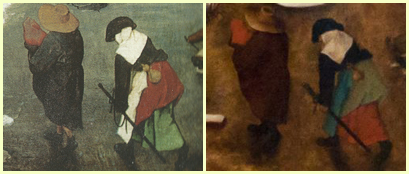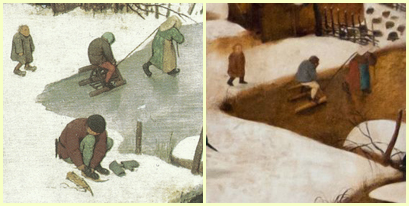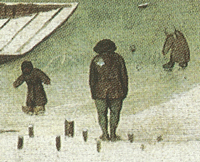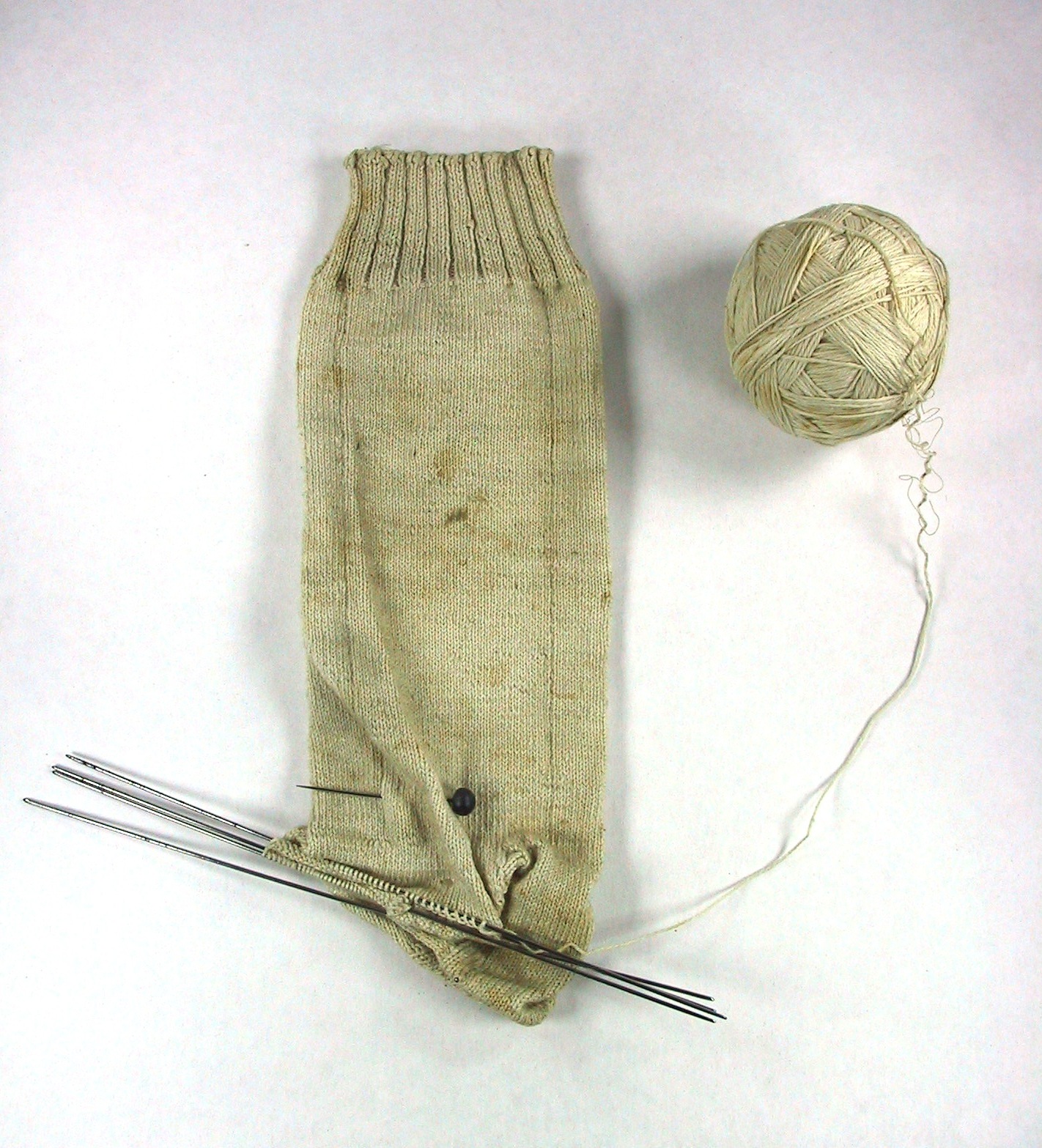after Afanas’ev
‘Something priceless must
have left the world, old man.
Why else would you cry like this,
sitting in the road rather than
pressing on and kicking up red dust
like others making
a journey? What is it?’
The fox took care to make his
tone kind. ‘I’ll sit here for a bit.
What’s in this bag? Is the weight taking
it out of you?’ ‘No.
O, don’t ask.’ The man stared
at his feet, vacant, aghast,
so the fox snuck a glance. Prepared
for dull luggage, his eyes widened so
much at what he saw
he looked away and coughed.
This was some windfall breakfast.
A bag full of pulped up meat, soft
flesh on the bone, pieces of a poor,
smashed person. The fox
turned back, mouth moist, gory
meal in mind. ‘What is my route
to this feast? I need the story
of his sadness first, of how the rocks,
so still, came to dash
apart a soul so dear
to him but, in this, pick fruit
from catastrophe for me.’ Tear
after tear hit the dirt, a sore rash
had flared in their tracks
on the man’s cheeks. ‘Come, old
friend, tell me. A burden shared
is halved or sometimes, so I’m told,
demolished altogether. Relax
and let me in,’ said
the fox, tougher in tone
but also as if he cared.
The man leant down and took a stone
from the tear-wet path. ‘My wife is dead,
but my sorrow’s start
was small, no bigger than
this pebble: a cabbage sprout.
Look over there, quite far off. Can
you see the prodigious plant, green dart,
rooted in that plot
but shot to the sky’s edge?
How it streaks up, almost out
of sight? That piece of mutant veg
flew up in a day, opened the spot
you just catch if you
strain your eyes, that black star,
that hole made in heaven’s heights.’
Fox traced the line of the green scar.
It arced across half the entire blue
expanse above them,
vanished into the mark
described. The man moaned. ‘By rights
I should be all set. Through that dark
puncture are riches: I climbed the stem
and looked through the gap.
I could never have dreamt
of the vast, unexplained wealth
I saw.’ ‘Gold?’ Trying to preempt
him, the fox misfired. A sudden snap
of sorrow: ‘It cost
me the love of my life.’
The fox, regrouping with stealth,
was understanding. ‘Your poor wife –
you must have tried to take her up, lost
your grip at the top.’
The fox laid his red paw
consolingly on the man’s
knee, but under his coat the claw
curled. ‘Tell me the whole story, don’t stop,
let out your deep grief
speaking. What did you see,
from beyond this plant that spans
the sky, to make your wife ready
to risk ascent to the highest leaf?’
Sob-hollowed and spent
the man grew calm and, plied
with soft incitement, resumed.
‘It would be clearer if I tried
to explain things from before they bent
sickeningly bad.
Out shopping yesterday
I bought a sprout. I presumed
it would grow in the normal way,
though the trader was strange, spoke with mad,
flat vowels like folk
from elsewhere, had suspect
eyes and was too keen to sell.
I planted it in the correct
fashion, plenty of water to soak
into its small roots,
bedded under the warm
ash in the firm hearth earth, well
protected from the threat of storm,
and safe, in good time, to put out fruits.
Then I went to bed
with my treasured wife.’ Here,
the fox cut in – ‘so it must
have spun itself up, ear by ear,
leaf by leaf, darkly. I see the head
jammed tight and straining
against the ceiling, stalk
a guitar string strung till just
about to whipcrack like a fork
of wire, vascular lightning, gaining
force in its freeing.’
‘Maybe that’s right; a whiff
of leaf stirred me - all I know
is I yelled and my wife woke, stiff
into a meringue of sheets, seeing
the intruding leaves
and hearing me shouting
if the plant didn’t get through
it’d ruin the house. Outing
it, though, meant climbing onto the eaves
and tearing off tiles
from the roof. I cleared six
and stuck my arm in, a blind
periscope after the apex
of the growth. “More to the left, you’re miles
away” my wife bawled,
guiding the search. I caught
it, pulled it across to find
the hole I’d made and, briefly, thought
I’d saved the day. But, freed, the sprout stalled
for a still second,
seemed to pause, and then smashed
into the sky with force stored
up overnight. Of course, I crashed
groundwards hard – I wagered death beckoned,
it was a big fall
from the height I was at
and the momentum that floored
me had explosive malice. Flat
on the earth, I was ready to call
my wife a goner –
in moments the growth had
obliterated the house,
levelled the walls like they were bad
props – but she’d escaped, debris on her
clothes, face, in her hair.
We watched the cabbage ride
skyward, me and my spared spouse
fast in each others’ arms, mouths wide,
heads bent right back, almost unaware
that our home had been
destroyed. We saw the high
birds punched out of broad flight like
botched staples, taken fully by
surprise. The sky became a blue screen
unstitching along
some hidden seam that proved
it green underneath. The spike
of the sprout’s tip drove on up, moved
with pure, motiveless purpose, a wrong
vitality, past
the staid clouds and closer
and closer to the bright sun,
a claggy yolk, yellow loser
in the face of mounting speed. At last,
us both prompt to burst
with held breath, the streak stopped,
sounding the stud noise of one
huge, distant, cosmic, semi-popped
balloon and a world-historic first –
that hole in the sky.
The silence settled. “Can
that really be a hole in
the sky?” My wife wondered with an
uneasy half-laugh, shutting one eye
to bring it into
focus. “I think it is,”
I replied, adrenaline
flushing me eager with a fizz
of resolve to climb up and look through.
“I’ll investigate,”
I announced. “For God’s sake,
be careful,” said my wife. There
was nothing she could do to make
me stay. Had I only known her fate
the way things went,
I’d have left the stark, black
star to preside in peace where
it hung. Instead, despite my lack
of fitness, I began the ascent.
The stalk’s fibrous sides
were easy to grip, its
leaves made good pit stops and I’ll
never forget, though all my wits
were to scatter, the strength I felt – tides
of drive seemed to roll
through me, moved by the draw
of that new, celestial
entrance: lunar, not stellar, law
governing, even taking control.
It was a long climb
and I kept passing scraps
of old house, pots, a little
icon showing the Virgin, wraps
of linen looping the leaf stalks. Time
passed. The air grew thin.
I thought of Jack, human
ant, chased for his white, brittle
bones by a giant. Stranger than
fiction, here I was being pulled in
to a tale. Fields turned
into brief squares, roads slight
gossamer. I didn’t see,
I was fixed on where the daylight
died above me. My whole body burned.
The hole seemed to surge
towards my rising face.
I leapt. The shadow met me,
stained my features like a surface
of water – I had a strange, strong urge
to laugh, balanced, rapt
at the cabbage’s tip,
leaning with one hand aching
up and out, my head at the lip
of the known universe.’ The fox clapped
his jaws together.
‘What’s hidden in that place?’
he gasped, not even faking
curiosity. ‘Boundless space,
and, suspended throughout the ether,
thousands of millwheels
extending beyond sight,
turning and, as they rotate,
regularly throwing out bright
loaves. I caught one. You know when bread feels
just right, light, but has
brittleness in the crust
that can prick you?’ ‘How I hate
bread,’ thought the fox, but grinned and thrust
out his tongue like he loved it too: ‘as
I live and breathe – wow,’
he said out loud. ‘There’s more,’
said the man. ‘My pupils pooled,
drawing the darkness off the store –
pans of milk, fresh from some flawless cow,
to moisten the bread:
the perfect complement.
I perched there staring and drooled,
overwhelmed by this heaven-sent
pension, ticket to an ever-fed
dotage, a vaultless
wonder-warehouse buttressed
by the sweep of the cabbage.
Remembering the loaf, I pressed
its crust, split in and partook. Faultless.’
Disappointed by
the lack of meat and cash
in this miracle storage
cave, factory, or divine cache,
the fox returned his sly and hungry
mind to the slick, fresh
joints in the tragic sack,
which meant hearing the next part
of the story. ‘When you got back
to your wife and earth – what then?’ the flesh
not missing from on
high but there, tasty, close
at hand, prompted him to start.
Like a terrible repeat dose
of the fact that his wife was all gone,
the question reduced
the man to sobs again
and he squashed his head hard south
into his hands as though the pain
required his palms be introduced
through his eye sockets
and his brain seized. Vowels
of grief forced open his mouth,
veering uselessly to howls,
not words. The fox searched in his pockets
for a handkerchief –
at least deal with the snot,
he thought – and rolled out the next
phase of his plan: ‘don’t curse your lot,
it may be that I can bring relief.’
The man wiped the glaze
off his upper lip, trance
of sorrow broken, perplexed
by the fox’s coy assurance.
‘It depends on how your story plays
out,’ the fox explained,
‘so tell me the rest, brave
the memory.’ Very faint,
the words: ‘I’d give my life to save
hers.’ In his head, the fox mocked this strained
claim. ‘I know you would,’
he lied, like an advert.
The man took up his complaint:
‘From the top, I saw my wife skirt
the base, staring up, anxious for good
news. I took one last
look at the firmament
of bread and milk, then I stowed
the loaf I held safe for descent
and began the downward climb as fast
as I could, thinking
about how she’d react
when I reached the ground and showed
her what I’d found. I made contact
with the red earth, cried out, ran blinking
into her arms. “What
did you find there?” she asked,
as though fresh from an ill dream
of her own. I took a pause, basked
in her wonder. “Wonders you would not
believe,” I beamed. “Fat
loaves flung cooling from wheels
and pans of rich, divine cream,
infinitely set out for meals,
as if heaven were nothing but that.”
Her sweet expression,
her wide open mouth: the
weak memory’s fading, pale
fake’s all I’ve left, along with a
corpse in a heap, what the aggression
of bare gravity
and rock made of her. Straight
away she wanted to scale
the heights too, attain the strange gate,
witness the stock in the cavity.
She picked up a bag
from amongst the scattered
remnants of our house and jumped
in, foetal, scrunching the tattered
brim round her head. “Haul me up like swag!”
she shouted, muffled
by hessian but full
of adventure. My heart pumped
hard: I felt too tired to pull
myself up the stalk, strangely ruffled
by this weird order
from my packaged wife, scared
that an extra load would be
beyond too heavy if I dared
try a second climb to the border
between plenitude
and the world. But to lose
face in the moment of glee
and triumph would have been a bruise
unbearable. It seems all too crude
now, apprehending
my selfish compulsion,
self-evident as rubble,
but it served then for propulsion:
I raised her, turned back to the bending
plant and remounted.
One hand is worse than two,
half much better than double
the weight in baggage for those who
climb. I couldn’t even have counted
on superior
skill and iron fitness
as you know, but the inlet
let me down too, no dark largesse
gifting magnetism any more
like the first time tried,
gift maybe overcome
by physical limit, sweat,
the loosening grip of my numb
fingers in green fibre of the side
and bone-white where my
wife depended on them.
The hole just hung, impassive.
My lungs crackled, threw up some phlegm
from the rack of breathing. I nearly
choked on a shatter
of coughs the clot provoked,
slipped sharply, felt my hand give,
my wife slip an inch, silent, cloaked
in sack. She called out: “What’s the matter?”
still calm, but fearful.
“Nothing,” I came back but
looked down talking and the height
hit me, land a nausea, cut
with unflat furrows, hedgerows. Tearful
with panic and shock,
unriveted by strange
attraction, I swung back, right
over open nothing; the change
in how I balanced made the sack rock
wider out still and
it was harder to keep
pinned in with my nails paring
flesh from the plant’s stalk and the sweep
of the bag out searing the bag-hand,
forcing my gaze up.
I let her go because
I saw the black blot staring,
noiseless, for the devil it was
in the good sky, damn the loaf and cup
of milk, the both damned,
evil like a desert
fraudulence. I let her go,
she dropped, I couldn’t reassert
the will to grip in time. When she slammed
into the ground, fleck
from where I was, I still
took a few seconds to know
that a fall from such a height will
kill. I came down. You found me, a wreck.’
Strategically,
fox let there be silence,
a moment’s seeming tribute,
then brought his false balm to the tense
aporia of conclusion. ‘I
am a doctor, known
far and wide for my skill.’
As he began to compute
this, the man’s eyes started to fill
with hope. ‘In my career, I have shown
that every scourge
that gruesomely afflicts
animal bodies is game
for curing, from the derelict’s
creeping sores, to fevers of the verge
of dying, to death’s
trusted confidence trick
itself. There’s no ill you’d name
that I couldn’t mend. Let me pick
up your wife, re-fuse her bones with breath’s
unifying rush
and return you to joy
where you saw only mourning,
the long horizon. I’ll destroy
her destruction and pull back life’s blush.’
At this, the man grabbed
the fox’s coat with low
sounds of excitement, fawning
in his face: ‘Do this, and I’ll owe
you everything, anything,’ he blabbed,
‘work, love, faith, money.’
‘This, in particular,
is an easy death to fix –
that’s why I asked details of her
demise. Bring me some oats and honey.
Then, I need to treat
her in private, behind
the plant. Everything clicks
into place in peace and shade.’ ‘Kind
fox,’ said the man. ‘The gift of this feat
will transform the rest
of my life. Let me get
oats.’ He went over the fence
to call on his neighbour, his wet
cheeks drying and his mind full of best
possible worlds, hope
restored. Doctor fox stood
by the coming succulence,
staring at it; the ordered food
was brought, wrapped in cloth and tied with rope.
He posed as solemn
as possible as he
took the bundle and then picked
up the heavier and bloody
sack, moving off towards the column
the plant made, doubled
under the bulk. He looked
tiny beneath the load, licked
his lips discreetly, the uncooked
feast soon due; the man was untroubled,
keen with awakened
faith. Then fox, nose, trunk, tail,
entered the shadow that lay
over the fields like a cold nail,
leaving the day to the wind-governed
trend of smoke rising
from placid chimneystacks
in the vague, abiding way
of the countryside, where an axe
will always split, at unsurprising
intervals, kindling
in some distant, wood-stocked
yard. After a fair while passed,
the man began to think: ‘he’s clocked
up too long there.’ His patience dwindling,
against instruction,
he went to determine
if his wife was yet recast
in corrected, unbroken skin
as per the promised resurrection.









